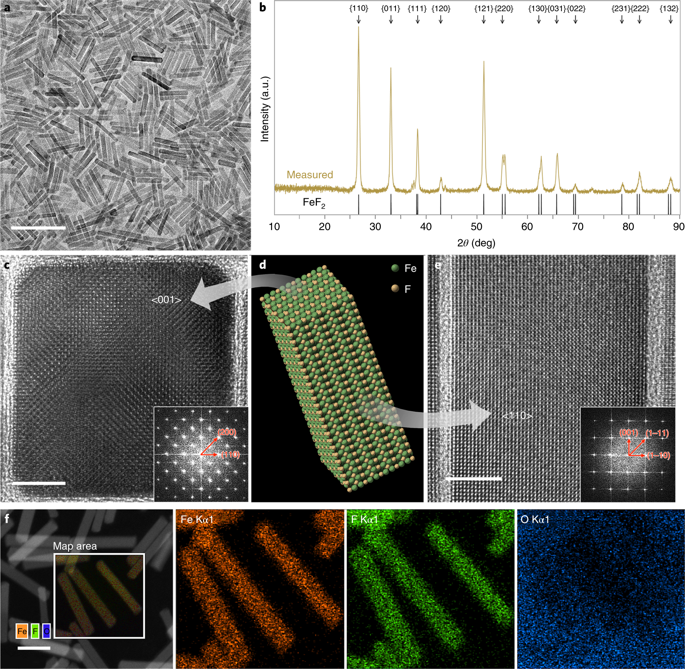Nature Materials ( IF 41.2 ) Pub Date : 2020-02-24 , DOI: 10.1038/s41563-020-0621-z Albert W Xiao 1 , Hyeon Jeong Lee 1 , Isaac Capone 1 , Alex Robertson 1 , Tae-Ung Wi 2 , Jack Fawdon 1 , Samuel Wheeler 1 , Hyun-Wook Lee 2 , Nicole Grobert 1, 3 , Mauro Pasta 1

|
The application of transition metal fluorides as energy-dense cathode materials for lithium ion batteries has been hindered by inadequate understanding of their electrochemical capabilities and limitations. Here, we present an ideal system for mechanistic study through the colloidal synthesis of single-crystalline, monodisperse iron(ii) fluoride nanorods. Near theoretical capacity (570 mA h g−1) and extraordinary cycling stability (>90% capacity retention after 50 cycles at C/20) is achieved solely through the use of an ionic liquid electrolyte (1 m LiFSI/Pyr1,3FSI), which forms a stable solid electrolyte interphase and prevents the fusing of particles. This stability extends over 200 cycles at much higher rates (C/2) and temperatures (50 °C). High-resolution analytical transmission electron microscopy reveals intricate morphological features, lattice orientation relationships and oxidation state changes that comprehensively describe the conversion mechanism. Phase evolution, diffusion kinetics and cell failure are critically influenced by surface-specific reactions. The reversibility of the conversion reaction is governed by topotactic cation diffusion through an invariant lattice of fluoride anions and the nucleation of metallic particles on semicoherent interfaces. This new understanding is used to showcase the inherently high discharge rate capability of FeF2.
中文翻译:

了解单分散FeF2纳米晶体阴极的转化机理和性能。
对过渡金属氟化物作为锂离子电池的能量密集型阴极材料的应用由于对电化学性能和局限性的了解不足而受到阻碍。在这里,我们通过单结晶的,单分散的铁(的胶体合成呈现为机理研究的理想系统II),氟化纳米棒。仅通过使用离子液体电解质(1 m LiFSI / Pyr 1,3)即可达到接近理论容量(570 mA h g -1)和出色的循环稳定性(在C / 20 50次循环后,容量保持率> 90%)FSI),可形成稳定的固体电解质中间相并防止颗粒融合。这种稳定性以更高的速率(C / 2)和温度(50°C)延伸了200个循环。高分辨率分析型透射电子显微镜揭示了复杂的形态特征,晶格取向关系和氧化态变化,全面描述了转化机理。相演化,扩散动力学和细胞破坏受到表面特异性反应的严重影响。转化反应的可逆性由全阳离子通过不变的氟化物阴离子晶格扩散和半相干界面上的金属颗粒成核所决定。这种新的理解被用来展示FeF 2固有的高放电速率能力。



























 京公网安备 11010802027423号
京公网安备 11010802027423号